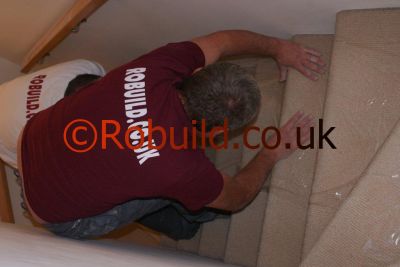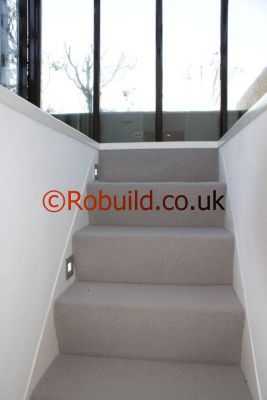Some chairs and sofas have decorative buttons on the seat and back; these often work loose and fall off and can mar the appearance of upholstery which is otherwise in a good state of repair. Fortunately, replacing them is a relatively simple task. If only one or two buttons are missing, you could cover the new ones with pieces of fabric taken from an inconspicuous part of the chair or sofa; if several are missing, you may find it easier to replace all the buttons and cover them in a contrasting fabric.
Metal button trims
These, which you cover with fabric yourself, are available in a range of sizes from haberdashery departments of large stores. They are in two sections: the round main part has small claws on the bottom onto which fabric is pressed and the other part is a cap which clamps the fabric down and secures it in position. If you are using the same fabric, take a piece out of the underside of the chair or sofa or from the tuck-ins of the lower inside arms. You will find it worth experimenting with the fabric and the button trims until you achieve the correct tension across the button face. If the fabric is very thick, which upholstery fabric often is, you may find it very difficult to fit it onto the button trims. You can take the spare fabric to the fabrics department of a large store where you should be able to have the buttons covered at a reasonable cost.
Fixing buttons
When you are fixing a button to the inside back of a chair or settee, it is worth taking the back cover off so you have access to the inside padding. Thread a length of thin stitching twine through the button and then thread the two ends of the length of twine through the eye of a long upholstery stitching needle. Mark the position of the button with a piece of tailor’s chalk on the inside back cover, push the needle through this mark and through the inside padding, making sure the twine comes right through with the needle. Use a slip knot to join the two pieces of twine securely together; but before pulling the knot tight insert a small piece or tuft of felt or cloth between the stuffing and the slip knot to prevent the knot pulling through later and making an unsightly hole. Tighten the slip knot by pulling one end of the twine. At the same time check the other buttons already in place; if they are deep-buttoned (pulled in very tightly into the upholstery), make sure you match up the depth of the button you are fixing with their depth and pull in accordingly. When the buttons are all the same depth, tie a reef knot to stop the slip knot coming undone later; cut off the twine ends for a neat finish. Where it is not possible to take off the back cover without a great deal of trouble, you can make a quick repair with the cover on. Thread a long upholstery needle with twine and insert it into the upholstery on the side where you are going to replace the button.
Push it through until the eye has passed through the front fabric and the inside padding, leaving one end of the twine about l00mm long on the side where the button will be replaced. Push the eye back so it emerges close to the insertion point ; pull the needle and take off the thread. Pull in both ends of the twine and trim to even them up, leaving enough to allow you to make a slip knot. Take one end and thread the button on, fixing it with a slip knot and pulling in both ends of the twine to secure it tightly. Check the button is in the correct position and finish off with a reef knot. Cut the ends back as far as possible and tuck them under the button.
Reversible cushions
These can be rebuttoned fairly easily but the technique is slightly different. Since you will be working with buttons which have to be sewn in the same position on opposite sides of the cushion, it is best to remove the odd one on the opposite side to the one you are replacing so you can start from scratch. If the stitch holes have enlarged through wear, carefully stitch up this area using a fabric thread pulled out from a place on the cushion which is normally invisible. Fix the buttons slightly away from this point, making sure they are not drastically out of alignment with the rest of the buttons on the cushion, Where necessary, carefully mark new positions for the buttons on each side of the cushion. Thread a length of twine through a button and thread both ends of the twine through the eye of a long upholstery needle. Push the needle through the marked point on one side, guiding it through the stuffing until it locates the marked point on the other side; pull it out and remove the thread from it. Thread the other button on one end of the twine and make a slip knot joining the two twine ends. Pull the slip knot tighter until both buttons are pulled in to the required depth. Secure the twine with a reef knot under the button and cut off the ends as short as possible so they are hidden under the button. Make sure you do not snip the upholstery fabric at the same time.
Repairing foam cushions
When a foam-padded cushion begins to sag at the edges (usually at the front) you will find it a simple matter to strengthen it. If the cushion cover has no zip, find the edge of the cover which has been hand sewn and carefully cut along this edge to remove the stitches. Pull out the foam pad; you will need to squash it a little to free it from the cover. Where the cover has a zip, be careful not to catch the loam against the zip edges when you are pulling it out. Locate the damaged part and, using a sharp knife or pair of scissors, remove it by making a cut across the foam at least 75mm away from the damaged section. Use the damaged piece as a pattern for cutting a replacement piece from the same kind of foam material, allowing an extra 25mm. Coat the edges of the replacement part and the places where they will meet the pad with impact adhesive, making sure you do so in a well ventilated room since this material is flammable. Allow the adhesive to become tacky and bring the two surfaces together, pushing them firmly in place. Allow the adhesive to dry completely, fold the loam and push it into the cover. Where necessary, sew the cover edges together using a half circle needle to make slip-stitches.






























